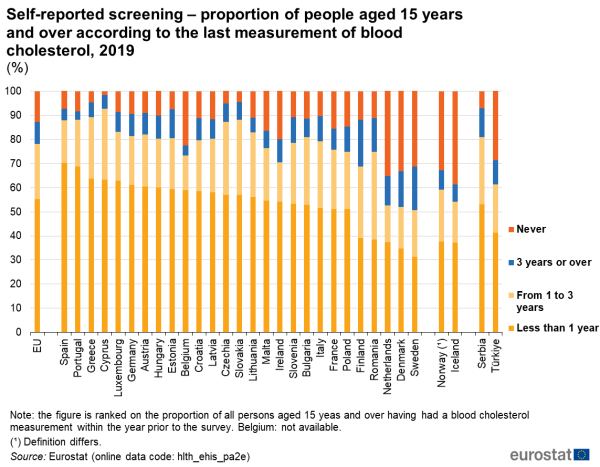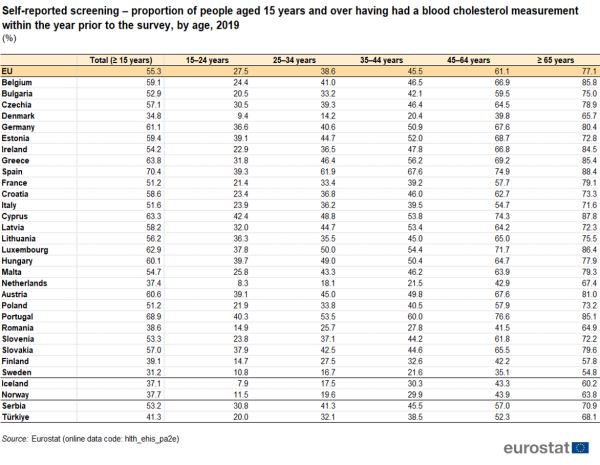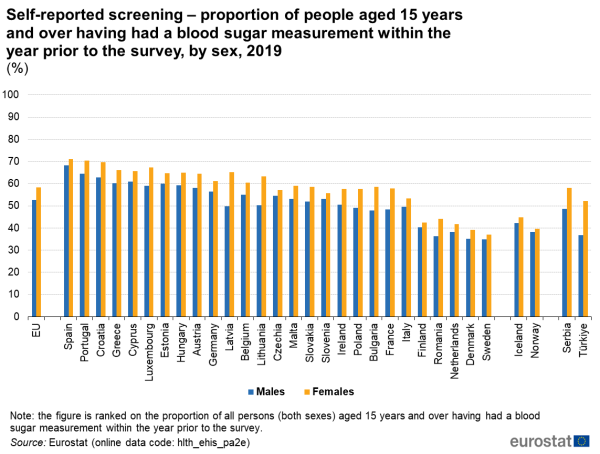Screening of cardiovascular diseases and diabetes risks - statistics
Data extracted in September 2022
Planned article update: September 2026
Highlights
In 2019, more than half (55.3 %) of the population in the EU reported that they had had a blood cholesterol measurement within the previous year.
In 2019, more than half (55.6 %) of all people aged 15 years and over in the EU had had a blood sugar measurement within the previous year.
Self-reported screening - proportion of people aged 15 years and over having had a blood cholesterol measurement within the year prior to the survey, 2019
This article presents an overview of European Union (EU) statistics related to self-reported screening of cardiovascular diseases and diabetes risks. The data come from the European health interview survey (EHIS) which relate to the 2019 reference year and cover persons aged 15 years and over.
Cardiovascular diseases are the leading cause of death in the EU. They cover a broad group of medical problems that affect the circulatory system (the heart and blood vessels). Some of the most common diseases that affect the circulatory system include ischaemic heart disease (heart attacks) and cerebrovascular diseases (strokes).
Cardiovascular diseases and diabetes are examples of non-communicable diseases (NCDs). The human and financial costs of NCDs are high and expected to grow, also considering the EU’s ageing population. Screening plays an important part in early detection and disease prevention.
Full article
Screening of cardiovascular diseases
The third wave of the EHIS included questions concerning important blood parameters related to the risk of diseases of the circulatory system and diabetes. Diseases of the circulatory system are an important cause of death for the elderly, while diabetes is also one of the main concerns for health care. Preventive actions related to those risks are strategic elements for the sustainability of the health care systems.
More than half of the EU population reported having had a blood cholesterol measurement within the previous year
In 2019, 12.6 % of the EU population (aged 15 years and over) reported that they had never had a blood cholesterol measurement (see Figure 1). This percentage varied from less than 5.0 % of the population in Cyprus, Slovakia and Greece to more than 30.0 % in Sweden, Denmark and the Netherlands; Norway and Iceland also recorded shares of more than 30.0 %.

(%)
Source: Eurostat (hlth_ehis_pa2e)
Conversely, more than half (55.3 %) of the population in the EU reported that they had had a blood cholesterol measurement within the year prior to the 2019 survey. Among the EU Member States, the rates concerning the measurement of blood cholesterol within this time period differed widely. More than two thirds of the population in Spain and Portugal reported having had a recent blood cholesterol measurement by a health professional, compared with less than one third in Sweden.
As might be expected, the likelihood of measurement of blood cholesterol was greater among older (rather than younger) people – see Table 1. More than three quarters (77.1 %) of persons aged 65 years and over in the EU reported having had a blood cholesterol measurement within the year prior to the 2019 survey, while this share was just over one quarter (27.5 %) among persons aged 15–24 years.
An analysis by EU Member State reveals that the share of the population aged 65 years and over having had a blood cholesterol measurement exceeded 50 % in all of the Member States. Shares above 80.0 % were observed in nine Member States, peaking at 88.4 % in Spain. In each Member State, these shares for persons aged 65 years and over were higher than for any of the other age classes shown in Table 1. In a similar vein, in nearly all Member States the lowest shares were observed for the youngest age group. The only exception was Lithuania, where the age group 25–34 years had the lowest share.

(%)
Source: Eurostat (hlth_ehis_pa2e)
Screening of diabetes
Concerning actions for the prevention of diabetes, 12.0 % of the EU population aged 15 years and over reported in 2019 that they had never had a blood sugar measurement by a health professional. There were seven EU Member States which recorded shares that were higher than the EU average, with a peak in the Netherlands where 30.1 % of the population had never had a blood sugar measurement (see Figure 2).

(%)
Source: Eurostat (hlth_ehis_pa2e)
Similar to blood cholesterol measurement, more than half (55.6 %) of all people aged 15 years and over in the EU had had a blood sugar measurement within the year prior to the 2019 survey. This share varied from just over one third of the population in Sweden (35.9 %) to two thirds or more in Croatia (66.7 %), Portugal (67.7 %) and Spain (69.8 %).
Women were more likely than men to have had a blood sugar measurement within the previous year
In 2019, women were more likely than men to report having had a blood sugar measurement within the previous year. On average, the percentage of women in the EU reporting having had a blood sugar measurement was 5.7 percentage points higher than the corresponding share for men (58.3 % compared with 52.6 %) – see Figure 3.

(%)
Source: Eurostat (hlth_ehis_pa2e)
Among the EU Member States, higher shares of women (compared with men) tended to report that they had had a blood sugar measurement within the year prior to the survey. In 2019, this gender gap was widest in Latvia, Lithuania and Bulgaria, where the share for women was at least 10.0 percentage points higher than that for men; a similar situation was observed in Türkiye. Finland (2.2 percentage points) and Sweden (2.3 points) recorded the narrowest gender gaps among the Member States, while a narrower gap (1.4 percentage points) was observed in Norway.
Source data for tables and graphs
Data sources
Self-reported statistics covering the health status of the population are provided by the European health interview survey (EHIS). This source is documented in more detail in the background article European health interview survey – methodology which provides information on the scope of the data, its legal basis, the methodology employed, as well as related concepts and definitions.
Although self-reported, the indicators on screening for cardiovascular diseases refer to the moment of last blood cholesterol, blood sugar or blood pressure measurement by a health professional. The data refer to measurements by a health professional and not by the respondents themselves. Health professionals are persons who – by education, training, certification or licensure – are qualified to and engaged in providing health care.
Symbols
Tables in this article use the following notation:
| Value in italics | estimate or provisional data; |
| Value is – | not relevant or not applicable; |
| Value is : | not available. |
Context
Primary prevention offers the most cost-effective, long-term strategy for reducing the burden of diseases across the EU. It involves tackling major health determinants (see Chapter 3), such as smoking, unhealthy diets and physical inactivity. The European Commission has supported many projects related to health determinants and health promotion in general.
Secondary prevention aims to reduce mortality by early detection, for example, the detection of cardiovascular diseases through screening.
In 2004, the Council Conclusions on heart health urged for actions on the prevention of cardiovascular diseases. The Luxembourg Declaration further established an agreement to strengthen plans for cardiovascular disease prevention through the adoption of measures, policies and interventions across all the European countries. Necessary measures included the raising of awareness regarding the reduction of cardiovascular disease risk factors:
- avoidance of tobacco consumption (zero tolerance);
- adequate physical activity (at least 30 minutes per day);
- healthy food choices;
- avoidance of being overweight;
- maintenance of blood pressure below 140/90 mmHg (millimetres of mercury);
- maintenance of blood cholesterol below 5 mmol/l (millimoles per litre).
In December 2021, the European Commission launched the Healthier together – EU non-communicable diseases initiative. The healthier together initiative aims to support EU Member States to identify and implement effective policies and actions to reduce the burden of major non-communicable diseases and improve health and well-being. The initiative promotes a holistic and coordinated approach to prevention and care. It covers the 2022–2027 period and includes five strands:
- health determinants,
- cardiovascular diseases,
- diabetes,
- chronic respiratory diseases,
- mental health and neurological disorders.
The World Health Organization (WHO) programme works on the prevention and monitoring of cardiovascular diseases and develops strategies for the effective reduction of risk factors affecting cardiovascular health.
Direct access to
See also
Online publications
Methodology
General health statistics articles
Database
- Health (hlth), see:
- Health care (hlth_care)
- Preventive services (hlth_prev)
- Self-reported screening of cardiovascular diseases and diabetes risks by sex, age and educational attainment level (hlth_ehis_pa2e)
- Preventive services (hlth_prev)
- European health interview survey (ESMS metadata file – hlth_det_esms)